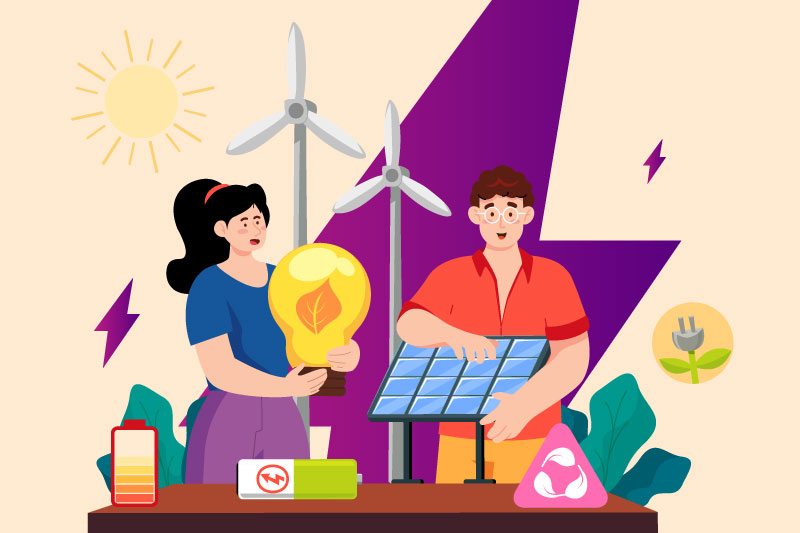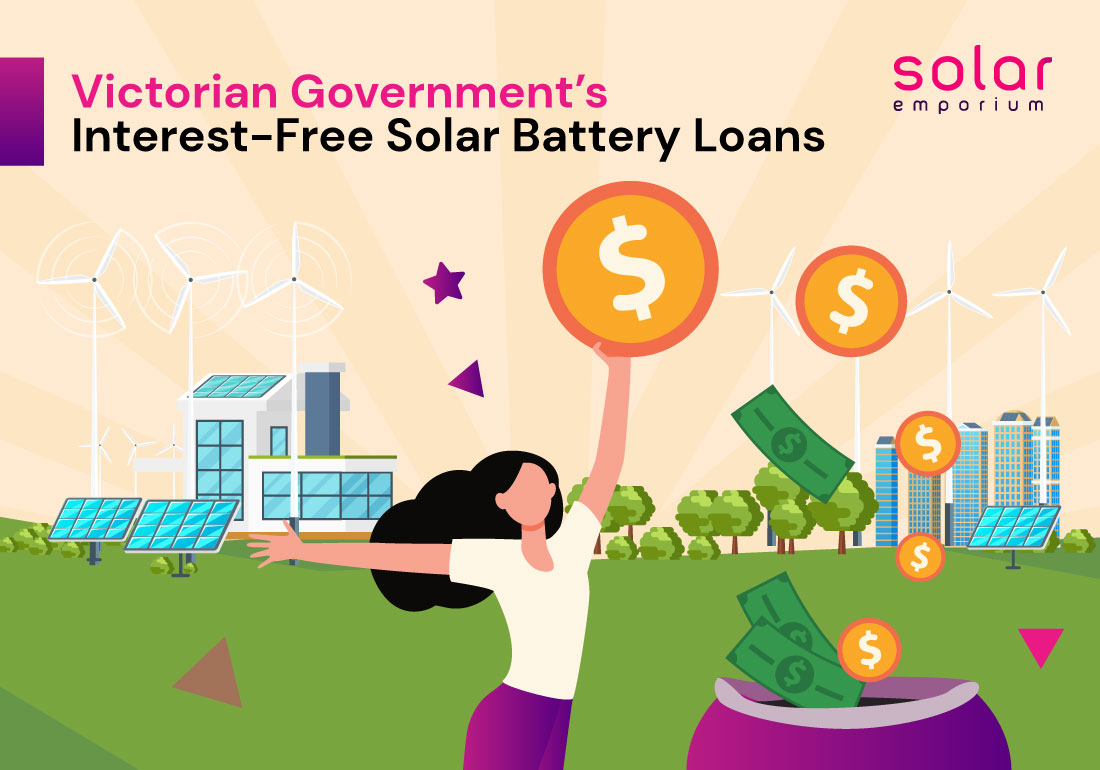The Victorian State Government has announced an innovative battery loan program for its $1.3 billion Solar Homes Program. This program aims to encourage residents to switch to renewable energy sources.
Under this initiative, Australian homeowners can access interest-free solar battery loans to install battery systems alongside solar panels. These loans will reduce upfront installation costs and enable solar storage to maximise energy output.
Minister for Energy and Resources, Lily D’Ambrosio, introduced an $8,800 interest-free battery loan. It will empower households to harness the full potential of their solar panels and save thousands of dollars on energy bills over the battery’s lifetime.
The ultimate goal of this program is to bring down energy expenses for Victorians. And it will contribute to the state’s commitment to achieving net-zero emissions by 2045.
Using the battery loan scheme, homeowners with existing solar panels can significantly increase their self-generated energy consumption. Consequently, this will double its current capacity.
Additionally, new customers can take advantage of the loan alongside the pre-existing $1,400 rebate and the $1,400 interest-free loan for solar photovoltaic (PV) technology. Ultimately it will save eligible households $11,600 on upfront installation expenses when installing solar and battery systems simultaneously.
After applying for the solar PV rebate and federal government small-scale technology certificates (STCs), the out-of-pocket installation costs for a solar and battery system can start at approximately $10,300.
For those interested in a standalone battery, prices range from about $8,000 for a 6kW/h battery to around $17,000 for an 11kW/h battery.
Minister Lily D’Ambrosio highlighted the significance of interest-free batteries in facilitating the transition to cheaper renewable energy. The initiative aligns with the state’s ambitious renewable energy target of 95% by 2035, promoting adopting reliable and affordable green energy solutions.
With the Solar Homes Program’s efforts, carbon emissions in Victoria have already been reduced by 1.7 million tonnes.
Here Are Some Points To Consider:
- The homeowner will still need to come up with $5,400 upfront, even after factoring in the $1,400 solar rebate and the $10,200 loan.
- It’s important to remember that the battery’s capacity will degrade over time. So adding another 3 months to the payback period would compensate for this degradation.
- The calculations are based on a fixed tariff of 27c per kWh. For those on a time-of-use tariff, the payback for the battery maybe even better.
A Quick And Approximate Analysis
Utilising the Solar and Battery Calculator assumes a $17,000 system consisting of 6.6kW solar panels and a 9.8 kWh solar battery.
Allocating $6,000 to solar panels and $11,000 to the battery for a homeowner in Melbourne with a pre-solar bill of $2,500 per year. The results indicate average savings of $142 per month in the first year.
If the loans come without any finance costs, the combined savings would take approximately 6 years to cover the $10,200 loan.
What Are The Eligibility Criteria?

Check out Solar Homes Program website to get details on Loan eligibility information. But before that, here is Solar Emporium’s brief take on the eligibility criteria.
Suppose you are a homeowner in Victoria and own an existing property where you plan to install a solar battery. In that case, you may qualify for a solar battery loan if you meet the following criteria:
- All owners’ combined household taxable income must be below $180,000 annually.
- The property’s value should be under $3 million.
- The property address has yet to receive a solar battery rebate.
- The property already has a solar panel system with an inverter capacity of 5kW or higher, or you intend to install one along with the solar battery.
- The energy storage you choose must have a capacity of 6kWh or more and should be listed on Solar Victoria’s battery product list.
- Additionally, the property should not have an existing energy storage system.
- You need to obtain pre-approval from your Distributed Network Service Provider (DNSP) to ensure a safe connection of the battery to the grid.
- As an owner, you must agree to receive information from your Distribution Network Service Provider about participating in battery trials to maximise the benefits for households.
- Battery storage may not be suitable for all households and situations. So conducting research is crucial as the first step in your battery journey.
- The solar battery rebate is not available for homes under construction.
Step 1: Conduct Thorough Research And Evaluate Suitability
- Lowering energy costs
- Climate change concerns
- Energy independence
- Ensuring backup power during blackouts
- Transitioning to an all-electric household
However, it’s essential to recognise that installing a battery represents a significant investment for most households.
To make an informed decision, conducting research is crucial. Before commencing the process, you should address the following questions to determine the right product for your specific requirements:
- How is energy typically used in your home?
- What should be the appropriate system size for your needs?
- What are the installation costs compared to the expected savings?
- What other factors should you take into account?
- Do you require a battery installation?
Step 2: Locate An Authorised Solar Retailer
After completing your research and determining the solar battery you require, it’s time to find the best retailers. Look for retailers offering multiple designs and quotes for your system.
To qualify for a solar battery loan, a Solar Victoria-authorised solar retailer must carry out the installation. These retailers meet the requirements set by Solar Victoria for participation in the Solar Homes Program, and specific terms and conditions bind them.
They employ Grade A electricians who hold Battery Endorsement and received accreditation from the Clean Energy Council (CEC).
We strongly advise obtaining at least three quotes for systems of similar size and functionality to ensure you get the best options.
Before finalising any deal with a supplier, conduct thorough research on the company, check customer reviews, and ask any relevant questions to help you feel confident that the proposed battery system is a wise investment for your situation.
At the very least, ensure that any deposit you pay to the retailer is fully refundable.
Your authorised solar retailer will furnish you with a written quote containing all the necessary information to make an informed decision. Additionally, they will upload your quote into the Solar Victoria Portal and start your eligibility application process.
Pre-Approval For Grid Connection Of The Battery

Before your chosen retailer can upload your quote to the Portal, they must obtain approval for grid connection from the Distribution Network Service Provider (DNSP).
DNSPs determine whether your solar panels or battery can connect to the grid.
It is essential to verify with your retailer that they have obtained pre-approval and inquire about any potential solar export constraints that may have been imposed.
These constraints can impact your feed-in tariffs and your ability to participate in Virtual Power Plants. Staying informed about this aspect is crucial.
Once your retailer has successfully uploaded your quote to the Portal, you will receive an email notification containing a link to complete your initial eligibility application.
Step 3: Complete Your Initial Eligibility Application

Once your retailer has uploaded your quote to the Portal, you will receive an email notification with a link to complete your initial eligibility application within the Portal.
If you apply for multiple solar home products, such as a solar panel rebate, an interest-free loan, and a solar battery loan, you will receive separate emails for each quote.
Accordingly, you will need to complete individual eligibility applications for each product. Also, if you wish to apply for a hot water rebate, you must confirm that you meet the eligibility criteria and submit a separate application.
When applying via the Solar Victoria Portal, you must provide proof of identity, income, and property ownership. Ensure you have all the necessary documentation readily available when you are ready to apply.
For proof of identity, you must enter details from any two forms of ID. It should include a driving licence or learner permit, Medicare card, Australian passport, Australian birth certificate, Australian citizenship certificate, foreign passport with a valid Australian Visa, or an Immicard. The names on the two documents should match.
Proof of property ownership is typically provided through your local council. If you need council rates notice for an established property, you can seek assistance from Solar Victoria.
Regarding proof of income, you must provide appropriate documentation for each person listed as an owner on your local council rates notice or a copy of your Certificate of Title.
If there are multiple property owners, proof of income documents for all listed owners are required, and each person’s documents should be from the same financial year.
It is essential to note that you, the customer, and not the solar retailer, must complete the initial eligibility check.







